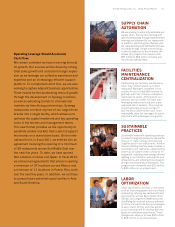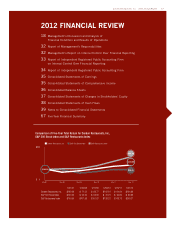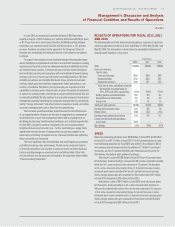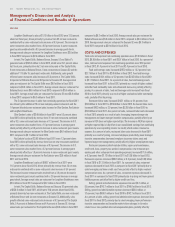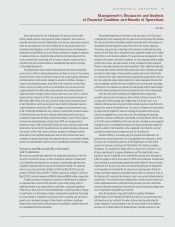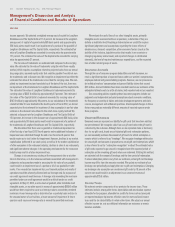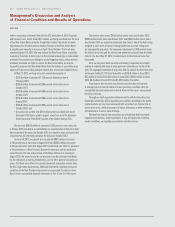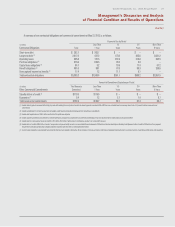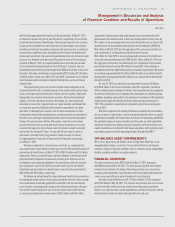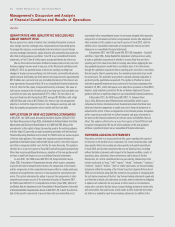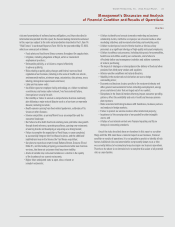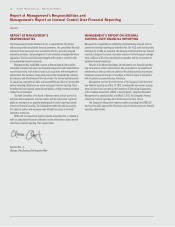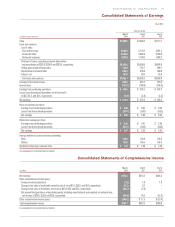Red Lobster 2012 Annual Report Download - page 29
Download and view the complete annual report
Please find page 29 of the 2012 Red Lobster annual report below. You can navigate through the pages in the report by either clicking on the pages listed below, or by using the keyword search tool below to find specific information within the annual report.
Management’s Discussion and Analysis
of Financial Condition and Results of Operations
Darden
Darden Restaurants, Inc. 2012 Annual Report 25
FASB ASC Topic 740, Income Taxes, requires that a position taken or
expected to be taken in a tax return be recognized (or derecognized) in the
financial statements when it is more likely than not (i.e., a likelihood of more
than 50 percent) that the position would be sustained upon examination by
tax authorities. A recognized tax position is then measured at the largest
amount of benefit that is greater than 50 percent likely of being realized upon
ultimate settlement.
We provide for federal and state income taxes currently payable as well as
for those deferred because of temporary differences between reporting income
and expenses for financial statement purposes versus tax purposes. Federal
income tax credits are recorded as a reduction of income taxes. Deferred tax
assets and liabilities are recognized for the future tax consequences attributable
to differences between the financial statement carrying amounts of existing
assets and liabilities and their respective tax bases. Deferred tax assets and
liabilities are measured using enacted tax rates expected to apply to taxable
income in the years in which those temporary differences are expected to be
recovered or settled. The effect on deferred tax assets and liabilities of a change
in tax rates is recognized in earnings in the period that includes the enactment
date. Interest recognized on reserves for uncertain tax positions is included in
interest, net in our consolidated statements of earnings. A corresponding liability
for accrued interest is included as a component of other current liabilities in our
consolidated balance sheets. Penalties, when incurred, are recognized in selling,
general and administrative expenses.
We base our estimates on the best available information at the time that
we prepare the provision. We generally file our annual income tax returns several
months after our fiscal year end. For U.S. federal income tax purposes, we par-
ticipate in the Internal Revenue Service’s (IRS) Compliance Assurance Process
whereby our U.S. federal income tax returns are reviewed by the IRS both prior
to and after their filing. The U.S. federal income tax returns that we filed through
the fiscal year ended May 30, 2010 have been audited by the IRS. In the first
quarter of fiscal 2012, the IRS completed the audit of our tax returns for the fiscal
year ended May 30, 2010 with no material adjustments. The Company’s tax
returns for the fiscal year ended May 29, 2011 are under audit, and are expected
to be completed by the second quarter of fiscal 2013. The IRS commenced
examination of our U.S. federal income tax returns for May 27, 2012 in the first
quarter of fiscal 2012. The examination is anticipated to be completed by the
first quarter of fiscal 2014. Income tax returns are subject to audit by state and
local governments, generally years after the returns are filed. These returns
could be subject to material adjustments or differing interpretations of the tax
laws. The major jurisdictions in which the Company files income tax returns
include the U.S. federal jurisdiction, Canada, and most states in the U.S. that have
an income tax. With a few exceptions, the Company is no longer subject to U.S.
federal income tax examinations by tax authorities for years before fiscal 2011,
and state and local, or non-U.S. income tax examinations by tax authorities for
years before fiscal 2002.
Included in the balance of unrecognized tax benefits at May 27, 2012 is
$1.0 million related to tax positions for which it is reasonably possible that the
total amounts could change during the next twelve months based on the
outcome of examinations. The $1.0 million relates to items that would impact
our effective income tax rate.
LIQUIDITY AND CAPITAL RESOURCES
Cash flows generated from operating activities provide us with a significant
source of liquidity, which we use to finance the purchases of land, buildings
and equipment for new restaurants and to remodel existing restaurants, to pay
dividends to our shareholders and to repurchase shares of our common stock.
Since substantially all of our sales are for cash and cash equivalents, and accounts
payable are generally due in 5 to 30 days, we are able to carry current liabilities
in excess of current assets. In addition to cash flows from operations, we use a
combination of long-term and short-term borrowings to fund our capital needs.
We currently manage our business and financial ratios to maintain an
investment grade bond rating, which has historically allowed flexible access to
financing at reasonable costs. Currently, our publicly issued long-term debt
carries “Baa2” (Moody’s Investors Service), “BBB” (Standard & Poor’s) and
“BBB” (Fitch) ratings. Our commercial paper has ratings of “P-2” (Moody’s
Investors Service), “A-2” (Standard & Poor’s) and “F-2” (Fitch). These ratings
are as of the date of the filing of this annual report and have been obtained with
the understanding that Moody’s Investors Service, Standard & Poor’s and Fitch
will continue to monitor our credit and make future adjustments to these ratings
to the extent warranted. The ratings are not a recommendation to buy, sell or
hold our securities, may be changed, superseded or withdrawn at any time and
should be evaluated independently of any other rating.
Until October 3, 2011, we maintained a $750.0 million revolving Credit
Agreement dated September 20, 2007 (Prior Revolving Credit Agreement) with
Bank of America, N.A. (BOA), as administrative agent, and the lenders and other
agents party thereto. The Prior Revolving Credit Agreement supported our com-
mercial paper borrowing program and would have matured on September 20,
2012, but was terminated on October 3, 2011 when we entered into the new
credit arrangements described below and repaid all amounts that were
outstanding under the Prior Revolving Credit Agreement.
On October 3, 2011, we entered into a new $750.0 million revolving Credit
Agreement (New Revolving Credit Agreement) with BOA, as administrative
agent, and the lenders and other agents party thereto. The New Revolving Credit
Agreement is a senior unsecured credit commitment to the Company and
contains customary representations and affirmative and negative covenants
(including limitations on liens and subsidiary debt and a maximum consolidated
lease adjusted total debt to total capitalization ratio of 0.75 to 1.00) and events
of default customary for credit facilities of this type. As of May 27, 2012, we were
in compliance with the covenants under the New Revolving Credit Agreement.
Additional information regarding terms and conditions of the Prior Revolving
Credit Agreement and the New Revolving Credit Agreement is incorporated by
reference from Note 9 to our consolidated financial statements in Part II, Item 8
of this report.
As of May 27, 2012, we had no outstanding balances under the New
Revolving Credit Agreement. As of May 27, 2012, $262.7 million of commercial
paper and $70.9 million of letters of credit were outstanding, which are backed
by this facility. After consideration of outstanding commercial paper and letters
of credit backed by the New Revolving Credit Agreement, as of May 27, 2012, we
had $416.4 million of credit available under the New Revolving Credit Agreement.
On October 11, 2011, we issued $400.0 million aggregate principal amount
of unsecured 4.500 percent senior notes due October 2021 (the New Senior Notes)


